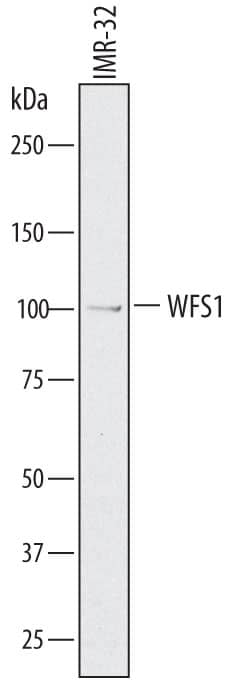Human WFS1 Antibody
R&D Systems, part of Bio-Techne | Catalog # AF7417

Key Product Details
Species Reactivity
Applications
Label
Antibody Source
Product Specifications
Immunogen
Lys679-Phe783
Accession # O76024
Specificity
Clonality
Host
Isotype
Scientific Data Images for Human WFS1 Antibody
Detection of Human WFS1 by Western Blot.
Western blot shows lysates of IMR-32 human neuroblastoma cell line. PVDF membrane was probed with 1 µg/mL of Sheep Anti-Human WFS1 Antigen Affinity-purified Polyclonal Antibody (Catalog # AF7417) followed by HRP-conjugated Anti-Sheep IgG Secondary Antibody (Catalog # HAF016). A specific band was detected for WFS1 at approximately 100 kDa (as indicated). This experiment was conducted under reducing conditions and using Immunoblot Buffer Group 8.Applications for Human WFS1 Antibody
Western Blot
Sample: IMR‑32 human neuroblastoma cell line
Formulation, Preparation, and Storage
Purification
Reconstitution
Formulation
Shipping
Stability & Storage
- 12 months from date of receipt, -20 to -70 °C as supplied.
- 1 month, 2 to 8 °C under sterile conditions after reconstitution.
- 6 months, -20 to -70 °C under sterile conditions after reconstitution.
Background: WFS1
WFS1 (Wolframin Syndrome gene 1; also Wolframin) is a 100-105 kDa intracellular glycoprotein that contains an unusual eleven transmembrane (TM) topology. It is widely expressed, being found in neurons, fibroblasts, hepatocytes, stratified squamous epithelium and pancreatic beta-cells. WFS1 is found in the ER and select secretory vesicles. It is known to be induced by ER stress, which prompts it to increase Ca++ in the ER, a condition necessary for proper protein folding. It also contributes to the maintenance of the proper pH in insulin-containing granules. Human WSF1 is 890 amino acids (aa) in length. It is a type II 11-TM protein that possesses a cytoplasmic N-terminus (aa 1-313) and transmembrane-embedded C-terminus (aa 870-890). WSF1 is reported to form homodimers and homotetramers. There are multiple mutations in the WFS1 gene that contribute to Wolfram syndrome. Among these are an isoform that generates a premature truncation at Ser157, a second isoform that possesses a seven aa substitution for aa 509-890, and a third isoform which shows a deletion of aa 508-512. Over aa 679-783, human WFS1 shares 95% aa sequence identity with mouse WFS1.
Long Name
Alternate Names
Gene Symbol
UniProt
Additional WFS1 Products
Product Documents for Human WFS1 Antibody
Product Specific Notices for Human WFS1 Antibody
For research use only
